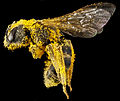 | species are the European Lasioglossum malachurum and the North American species Lasioglossum zephyrus. List of Lasioglossum species Gibbs, J., et al.... 5 KB (482 words) - 09:12, 14 August 2023 |
 | in the abdominal cavities of the primitively social sweat bee, Lasioglossum zephyrus. Inside the female body, the nematode hinders ovarian development... 69 KB (7,446 words) - 01:59, 7 May 2024 |
 | burrow into the ground to create their nests. H. ligatus, like Lasioglossum zephyrus, is a primitively eusocial bee species, in which aggression is one... 24 KB (3,392 words) - 03:49, 12 January 2024 |
in the genus Lasioglossum. Contents A B C D E F G H I J-K L M N O P Q-R S T U-V W-Z Notes Lasioglossum abanci (Crawford, 1932) Lasioglossum aberrans (Crawford... 113 KB (7,232 words) - 17:21, 8 November 2023 |
 | flowers, including the sweat bees Augochlora pura, Lasioglossum subviridatum, and Lasioglossum zephyrus. The fruits are eaten by birds. Leaves and tendrils... 7 KB (675 words) - 13:42, 23 July 2023 |
 | The plants are pollinated by insects, especially the sweat bee Lasioglossum zephyrus, which has been observed opening the buds to remove pollen before... 5 KB (580 words) - 16:53, 19 December 2023 |
is found in groups of nests, similar to the American sweat bee Lasioglossum zephyrus, and these groups are more numerous at higher elevations. Nests... 18 KB (2,494 words) - 02:21, 29 September 2023 |
predation, and reproductive behavior, for example, finding that female Lasioglossum zephyrus sweat bees have individual odors perceived by conspecific males... 8 KB (988 words) - 11:36, 20 April 2024 |
 | bodies are a shiny, bright green, in contrast to many Lasioglossum species such as L. zephyrus, which are a dull metallic green. Male Augochlora pura... 13 KB (1,643 words) - 03:56, 13 February 2024 |
Flavipanurgus granadensis Halictus carinthiacus Halictus microcardia Lasioglossum breviventre Lepidoptera comprises moths and butterflies. There are 51... 61 KB (4,018 words) - 19:38, 11 May 2024 |
Flavipanurgus granadensis Halictus carinthiacus Halictus microcardia Lasioglossum breviventre Lepidoptera comprises moths and butterflies. There are 51... 25 KB (1,695 words) - 13:36, 19 December 2023 |
Bristle-tipped sanddargon (Progomphus tennesseni) Elusive sanddragon (Progomphus zephyrus) Subspecies Asiagomphus amamiensis amamiensis Asiagomphus amamiensis okinawanus... 38 KB (2,554 words) - 03:54, 13 February 2024 |









